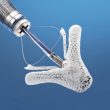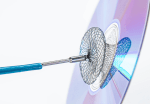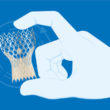Degenerative mitral valve regurgitation affects the mitral apparatus and is related to severe insufficiency. At present, surgery is the treatment of choice for patients at low risk. Oftentimes, this disease affects the elderly and/or those at high surgical risk, edge-to-edge repair being an excellent treatment alternative. We all know that the different stages of ventricular...
12-Month Evolution of Edge-to-Edge Repair with PASCAL
Mitral regurgitation (MR) is the most frequent valve disease. Mitral transcatheter edge-to-edge repair (M-TEER) has been shown beneficial in high or prohibitive risk patients in cases of degenerative and functional MR. The PASCAL device has been shown safe and effective by the CLASP II, but we still need further research in clinical “real world” environments. ...
Transcatheter Myotomy for the Treatment of the Dynamic Obstruction of the Left Ventricular Outflow Tract
Septal reduction therapies are used to mitigate the symptoms caused by dynamic left ventricular outflow tract (LVOT) obstruction and the associated mitral regurgitation (MR) that can surge in hypertrophic cardiomyopathy (HCM). Alternative therapies to treat LVOT obstruction include surgical procedures, i.e. surgical myotomy or myomectomy, or alcohol and radiofrequency septal ablation (intracardiac, transthoracic and endocardial,...
TENDER Study, Evolution at One Year
The use of transcatheter mitral valve intervention for the treatment of mitral valve regurgitation (MR) continues to evolve; at present guidelines only recommend it for inoperable or high surgical risk patients. So far, many devices have been assessed, some of which have shown promising results, but only for poor surgical candidates. Researchers looked into the...
Edge-to-Edge Repair in Cardiogenic Shock
The edge-to-edge approach with MitraClip has been established as a valid strategy for patients who experience severe symptomatic mitral regurgitation (MI) with high risk for surgery, currently with a IIa indication. MI complicated by cardiogenic shock, which results in a high risk for conventional valve surgery, is a particularly complex scenario. In such a case,...
MYVAL, a TAVR Balloon-Expandable Valve with Promising Results
TAVR has been shown beneficial over time, and with the development of new generation of prosthetic valves and implantation techniques, outcomes have been improved, reducing the incidence of leaks y and the need for definite pacemaker. This study looked at the evolution of 100 patients with symptomatic aortic stenosis treated with Myval THV from Meril...
EVOQUE: Transcatheter Tricuspid Valve Replacement, One-Year Outcomes
Treating tricuspid regurgitation (TR) has gained increasing importance in interventionism. There is abundant literature on the negative natural evolution of this condition and its unfavorable prognosis, as well as the clinical challenges associated to optimal medical treatment. Among its percutaneous treatment options, both edge-to-edge repair devices (TEER), as showed in TriValve and TRILUMINATE trials, and...
Untreated Aortic Stenosis: Associated Mortality and a Call to Attention
The progression of aortic stenosis has been extensively studied and is well-known. As observed, in its advanced stages, this condition entails high morbidity and a marked decrease in survival. Both North American and European guidelines recommend treatment when faced with severe valve disease. However, true severity can be difficult to determine due to discordant data,...
Left Atrial Appendage Occlusion: Clinical Outcomes according to Device Implantation Depth
Continuous improvement of left atrial appendage occlusion (LAAO) devices has had a positive impact on the safety and efficacy of this technique. However, device related thrombus formation (DRT) is still a major concern because of the associated increased risk of thromboembolic events. Approaching this complication calls for more intense antithrombotic treatments, which in turn involves...
TAVR Durability at 5 Years in Intermediate Risk Patients
TAVR has been shown beneficial in patients across the risk spectrum. The PARTNER 2 SAPIEN 3 (P2S3i) study on intermediate risk patients was the first to show TAVR superiority vs SAVR when using the transfemoral approach. SAVR durability has been shown in different analysis but, except for a few reports, TAVR durability at long term...









